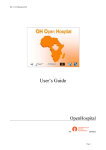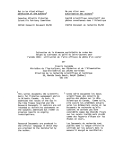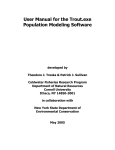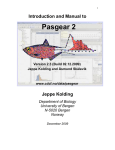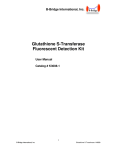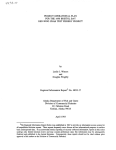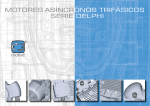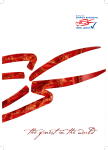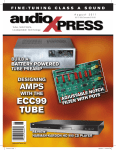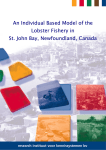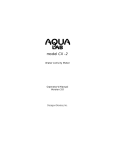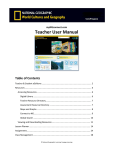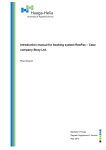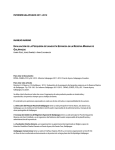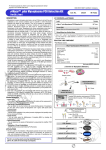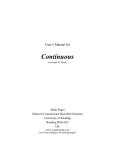Download A reference guide to the ADF&G shellfish literature database.
Transcript
A REFERENCE GUIDE TO THE
ADF&G SHELLFISH LITERATURE DATABASE
BY
Ruth M. Ryan
and
Margaret C. Murphy
Special Publication No. 10
Alaska Department of Fish and Game
Commercial Fisheries Management
and Development Division
P.O. Box 25526
Juneau, Alaska, 99802-5526
May 1995
AUTHORS
Ruth M. Ryan is a graduate intern and Margaret C. Murphy is the statewide shellfish biometrician
with the Alaska Department of Fish and Game, Commercial Fisheries Management and Development
Division, P.O. Box 25526, Juneau, AK 99802-5526.
ACKNOWLEDGMENTS
This report was prepared from extensive, detailed notes compiled during development of the Shellfish
Literature Database. Robert L. Wilbur, scientific report editor, reviewed this report. Gordon H. Kruse,
marine fisheries scientist, was involved in development of the Keyword Table and provided
organizational support throughout development of the database. Paul DeSloover, division librarian,
Mukhya Khalsa, analystlprogrammer,
researched many incomplete and inaccurate references.
provided, technical networking and software support.
Denny Johnson, analyst/programmer,
contributed insight into the division's statewide network and file-sharing capabilities for each site
where shellfish staff are located. Publications specialist Kurt Savikko and publications technician
Katherine Aschaffenburg contributed technical and editorial support during report production. Jan
Seitz, administrative clerk, contributed user feedback during review of initial drafts.
TABLE OF CONTENTS
PART I .INTRODUCTION AND GENERAL INSTRUCTIONS
Page
1.
THE PAPYRUS SOFTWARE ...................................................................................................
2.
THE DATMiASE STRUCTURE ..............................................................................................1
3.
GAINING ACCESS TO PAPYRUS .......................................................................................... 2
1
PART .XI.ENTERING DATA
4.
JOURNALS ................................................................................................................................ 3
Adding New Journal Titles to the Dictionary ................................................................ 3
Entering New Journal Titles While Entering References ............................................. 3
Editing JournaI Titles ....................................................................................................
3
5.
KEYWORDS ..............................................................................................................................4
Identifying Keywords .................................................................................................... 4
Adding Keywords to the Keyword Dictionary ..............................................................4
Entering Keywords While Adding References ..............................................................5
Updating the Keyword Table ........................................................................................5
6.
ENTERING BIBLIOGRAPHIC REFERENCES.......................................................................5
Articles...........................................................................................................................6
Books .............................................................................................................................8
Chapters .........................................................................................................................
9
Maps ..............................................................................................................................9
Patents ............................................................................................................................ 9
Theses .......................................................................................................................... 10
Quotes .......................................................................................................................... 10
Other ............................................................................................................................ 10
PART ID .SEARCHING THE DATABASE
7.
QUICK SEMW?fES ................................................................................................................ 11
8.
SEARCHES USING CRITERIA ............................................................................................. 11
9.
BIBLIOGRAPHIC FORMATS ................................................................................................ 13
Selecting Formats from the Format Libraries ............................................................. 13
Defining Your Own Output Format ............................................................................ 14
Importing References From Other Databases ............................................................. 16
Citing References in a Manuscript ..............................................................................16
10.
EXAMPLE SEARCHES ..........................................................................................................
Quick Search ................................................................................................................
Compiling Bibliographies Using Other Formats .........................................................
Sorting the Search Listing ..........................................................................................
17
17
19
20
PART IV: APPENDIX
A . Species Names ....................................................................................................................
25
B . Journal List ..........................................................................................................................
29
C . Keyword Table ....................................................................................................................
39
PART I
INTRODUCTION AND GENERAL INSTRUCTIONS
The Shellfish Literature Database has been compiled to catalog research literature collected by the
department's marine fisheries scientist and the statewide shellfish biometrician. Cataloging literature
in a bibliographic database enables shellfish staff to access the literature in a timely and efficient
manner and to share area-specific and diverse holdings around the state. Shellfish managers,
biometricians and biologists need quick access to shellfish literature when developing new fishery
management plans, writing technical issue papers and reviewing manuscripts.
The purpose of this reference guide is to provide users with the essential tools for creating
bibliographies from the Shellfish Literature Database. Keywords, journals, and species specific to
this database are listed in the appendices. Users are encouraged to consult the Papyrus software
manual a i d workbook to learn the more intricate features Papyrus has to offer.
1
DATABASE SOFTWARE
The Shellfish Literature Database has been created using Papyrus Bibliographic Systems, version
7.0.2, produced by Research Software Design in Portland, Oregon. This software is designed
specifically to store bibliographic citations and related information. It sorts, groups, and retrieves
citations upon request and can print bibliographies in a variety of formats. The software requires
approximately 470K of free RAM memory to run the program and database files. At the time of
initial distribution, the Shellfish Literature Database included over 4,500 bibliographic references and
required approximately 6 megabytes of hard disk space. Individual copies of the software reside on
networks in each area office where shellfish staff reside. The software license limits the number of
distinct Papyrus databases to four (rather than the number of computers on which it can be used).
2.
THE DATABASE STRUCTURE
The related parts of the database are maintained in separate areas within the structure of the database.
References comprise the substance of the database and contain the information normally found in
bibliographic citations.
Journal titles are contained in a dictionary along with abbreviated titles for more convenient and
speedy entrylretrieval.
Keywords are contained in a dictionary.
Formats are shell documents that arrange fields within a reference and a list of references from the
database in a specific arrangement according to journal or user-specified conventions.
Papyrus provides libraries of standard formats that may suit your needs, but the users can also
define a style of his or her own. See Section 9 for more information on formats.
~nforrnationfrom each of these areas is drawn together to compile citation entries for bibliographies.
Any combination of references can be grouped together to generate a bibliographic list according to a
specified format.
3.
GAINING ACCESS TO PAPYRUS
Each area's local network administrator is responsible for loading Papyrus, the Shellfish Literature
Database, and subsequent upgrades to the network. See Papyrus reference manuals for installation
procedures. If the Papyrus software and database will be installed directly to the hard drive of a PC
rather than to a network, please note the previously listed memory requirements.
Before you attempt to use Papyrus, have your Network Administrator add you to the Papyrus user
group on the network. In addition, if you are using Microsoft Windows, you will want to have the
Papyrus icon installed on your desktop.
Contact the Statewide Shellfish Biometrician in Juneau with any questions about the contents of the
database. Specific user questions about Papyrus may be better answered by contacting Research
Software Design. Contact information is listed in the software user's manual.
PART I1
ENTERING DATA
The database will grow with each new entry. Within this section are several brief guidelines to follow
when adding new references to the database.
4. JOURNALS
Titles of many scientific journals covering fisheries research topics have already been added to the
Journal Dictionary along with their abbreviations. Additional titles and their abbreviations can be
added to the dictionary as needed.
Adding. New Journal Titles to the Dictionary
From the REFERENCE OPTION menu choose JOURNALS. From the JOURNAL OPTION menu
choose INPUTIEDIT. Type the full name of the journal in the space provided. Papyrus will ask if
this is a new journal (yestno response). If yes, a pop-up window will be provided to enter the
following information:
- Full Journal Title:
- Standard Abbreviation:
- Routinely Cite:
(the title you provided will appear here)
(enter the abbreviation; Brief abbreviations can be included)
Issue? (nly) Daymonth? (dy) Series? (dy)
Press ENTER when completed.
If you indicate "y" (yes) in any portion of the Routinely Cite field, Papyrus will present these fields
automatically in the entry format when entering any article from that particular journal.
Entering New Journal Titles While Entering References:
Occasionally, you may begin entering a new reference to the bibliographic database and find that the
journal title you've entered does not match the titles in the Journal Dictionary. A pop-up window
will appear that asks if this is a new journal title. Before selecting YES, check your spelling to avoid
entering a misspelled title that could cause problems later. If the title is indeed new, select YES, type
the title and its abbreviation in the blanks provided, and press the ENTER key.
Editing Journal Titles
If you detect a misspelled journal title or abbreviation, you can correct the error by editing the listing
in the Journal Dictionary. Select JOURNAL from the main menu and choose INPUTIEDIT. At the
prompt, enter the name or abbreviation as entered in the Journal Dictionary. Confirm at the prompts
that this is indeed the journal you wish to change. A pop-up window will present the full journal title
and abbreviation as previously entered. Make any changes you wish and select OKAY to save.
Papyrus will automatically update all references using that specific journal title.
If both a misspelled journal title and a correctly spelled journal title have been entered to the Journal
Dictionary, Papyrus will not allow you to edit the incorrect title so that it duplicates the correct title.
3
Instead of following the instructions outlined in the previous paragraph, you will need to use the
Search feature to identify each reference that contains the incorrectly spelled journal title and correct
them one at a time. When all selected references have been changed, delete the misspelled journal
title from the Journal Dictionary.
5. KEYWORDS
The inclusion of keywords in citation references allows one to perform quick topic-focused searches
of the database. Papyrus allows users to assign up to 100 keywords to each reference and to search
any combination of keywords, authors, editors, year, title words, and abstract words. A hierarchical
master keyword table of related terminology has been developed for use with the Shellfish Literature
Database (Appendix C).
Identifying: Keywords
Keywords, also known as indexing terms or descriptors, reflect the central topics of the reference and
can be quickly identified throughout the document. You might find document titles helpful for
determining the focus of a document, but it also helps to skim through the abstract, introduction,
methods, and conclusion sections to gain more information about the document. Some documents
provide a list of keywords (usually below the abstract) that you may find useful.
The Keyword Table in Appendix C was compiled separately from the Papyrus database and can be
used as a reference tool as documents are entered into the database. Terms commonly used in
fisheries research and management have been grouped within topics (and subtopics) and listed under
topic headings. As you identify keywords from the text of the document, refer to Appendix C to
determine whether the topics and terms you would like to use have already been listed--or if another
keyword could be substituted.
Addine Keywords to the Keyword Dictionary
Occasionally, you may wish to add keywords directly to the Keyword Dictionary. From the
REFERENCE OPTION menu, choose KEYWORDS. Select the default on the KEYWORD OPTION
menu: INPUTEDIT.
Papyrus prompts you to enter the keyword:
[ Keyword InputEdit ]
Keyword:
Type your choice and press ENTER. Papyrus will ask you to confirm that your keyword is indeed
new. (At this point you will want to double check your spelling. If the keyword already exists,
Papyrus will prompt you that it does. Be aware that Papyrus does not recognize inadvertent
duplication; i.e., singular/plural forms of a word, or misspellings.) The default response is YES. The
keyword is now added. Press ESC (escape) to return to the KEYWORD OPTION menu. Press
ESCAPE again to return to the REFERENCE OPTION menu.
Entering Keywords While Adding References
New keywords can be added directly to the Keyword Dictionary while entering new references by
simply typing the new word in the Keyword field and pressing ENTER. Papyrus will respond by
asking if this represents a new keyword. If you respond with YES, Papyrus will automatically add the
new keyword to the keyword dictionary. Be sure to check for misspellings before selecting YES.
When you enter a keyword, Papyrus checks for matches in the keyword dictionary that begin with the
letters you've typed. Occasionally, the keyword you enter will be the "root" of one or more keywords
already identified in the Keyword Dictionary. If Papyrus locates more than one match, it will prompt
you with a list of possibilities to choose from. If you don't like any of the choices, press ESCAPE. If
there is only one match, Papyrus will replace your entry with its matching keyword. Sometimes
Papyrus is too helpful and will expand your new keyword entry to one already recognized, (e.g.,
replacing "feeding" with "feeding behavior" if that is the only match found.) To avoid this
replacement enter an exclamation point directly after the keyword: "FEEDING!"
You can also use the F2 key to choose from a list of alphabetized keywords. At the keyword prompt,
type the first few letters of the keyword and press the F2 key. If you don't wish to use any of the
keywords listed, press ESC.
Updating the Keyword Table
Although Papyrus operates as a relational database and updates various related tables and dictionaries
with a single command, the Keyword Table is not a Papyrus document and must be maintained
separately. The Keyword Table in Appendix C has been prepared as a Word 6.0 for Windows
document.
6. ENTERING BIBLIOGRAPHIC REFERENCES
Open the database. From the REFERENCE OPTION menu, choose INPUT. (Note that this is
highlighted as the default.) Press ENTER.
Papyrus allows users to enter bibliographic reference data in a variety of reference types: article,
book, chapter, map, patent, thesis, quote, and other. The entry screen appears with the TYPE menu
pulled down and ARTICLE chosen as the default. This may in fact be what you want to choose, but
if it isn't, use the UPIDOWN ARROW keys, your mouse, or type the first letter (boldfaced) of your
choice to change the reference type.
*
*
*
*
For published journal articles use the Article entry format.
Unpublished ADF&G reports and papers are also entered as Articles, using
"Unpublished document" as the Journal title. This is bending the definition of
articles somewhat, but entering them as Articles provides users more flexibility to
sort and group these entries than does the Other format.
Chapters in books and significantly distinct sections in publications are entered as
Chapters.
Theses or dissertations are entered in the Thesis entry format.
*
*
Documents (brochures, newsletters, etc.) that have been printed and distributed
without formal publication are entered as Other.
Memos, letters, and other correspondence are not considered citable references and should
not be included in this database.
Each reference in your Papyrus database is composed of many fields. Some of these fields are
available regardless of reference type, while others are specific to one or more reference type. The
fields provided in each reference type are either required or optional and can be designated as such by
the user. You can change the default setings for each reference type by selecting PREFERENCES
from the REFERENCE OPTION menu, then HIDDENREQUIRED from the PREFEENCES menu,
and follow the prompted instructions.
Articles
The entry screen for Articles appears as follows:
Edit
Reference
Reference #
Author #1
Year
Title
Journal
Volume #
Page(s)
Accession No
Location
[ Abstract ]
[Comments ]
[Keyword #1 ]
View
Type
ARTICLE
11 4091
II
I1
II
I1
II
I1
II
II
I1
I1
ll
The first eight field names following the reference number require data to be entered in order for the
citation to be considered complete. The last three fields (noted here in brackets) are optional. Note
that required field names are shown in one color and optional fields in another (you can specify the
colors in PREFERENCES).
Reference #:
Papyrus provides this number. Each entry is numbered consecutively as you
add references to the database.
Author #1:
Last name first, comma, and initials. No need to enter periods, as Papyrus
will delete them in the standard entry format and journal formats will add
them where appropriate.
'
Additional authors may be entered. Papyrus will automatically offer an
optional Author #2 field.
In an attempt to prevent duplicate entries, the Papyrus software has been
designed to prompt users when duplication is about to occur. If another
citation has already been entered with an author's name, Papyrus will present
a list of the other entry(s) and inquire whether you wish to continue adding
the new entry.
Year:
If the document has been published within this century, you need only enter
the last two digits. Otherwise, specify the complete year.
Title:
Enter the title as it appears in the article. Specific words can be italicized
(scientific names), boldfaced, or altered by enclosing the word(s) in braces
{ I . You can control the specific effect by using a specified character
immediately following the opening braces. That is,
{iCancer magister}
{bCancer magister)
{uCancer magister}
to italicize,
to boldface, or
to underline.
Journal:
Type the abbreviation for the journal. If you don't remember the exact
abbreviation, type the first few letters and press F2 to display a listing of
closely related titles from which to choose. If Papyrus does not recognize
the journal title, it will present an entry box for you to enter the journal title
and abbreviation and add it to the journal listings. Once again, check your
spelling to avoid inaccurate duplication.
Volume #:
Enter only the volume number. Press ENTER. To enter the issue number
(this field is not automatically shown), press ALT-H. Enter the issue number,
press ENTER, then press ALT-H again to "hide" the other optional choices.
Page(s) :
Enter the page numbers on which the article occurs in the journal.
Accession
Number:
The Accession Number entry field is also referred to as the location code, and
directs the user to the physical location where the document can be found.
Each user or group of users in a local area office should establish.inventory
conventions suitable to their needs.
Location:
For this database, the location is designated by the initials of the individual(s)
holding the document.
[ Abstract: ]
Abstracts have not been included in this database.
[ Comments: ] Generally, comments aren't included. Occasionally, notations are included
that a user might find valuable (e.g., an article is printed in Japanese rather
than English).
[ Keywords:]
A collective listing of keywords was developed for this database and is
maintained by Papyrus. Keywords are considered optional by Papyrus
(rather than required) so that citations may be considered complete without
keywords. However, for search purposes, each document was reviewed and
keywords selected to identify the contents of the document.
7
If unsure about the spelling of a keyword (or whether it's one Papyrus
"knows"), enter the first few letters of the keyword and press F2. Papyrus
will present a related alphabetical listing of keywords, one of which you may
be looking for.
When all fields have been entered, press ALT-S to save the entry. (If you prefer using menus, pull
down FILE and select SAVE.) When your entry is saved, Papyrus will present the data-entry screen
with the next consecutive reference number. You can either proceed with another entry, or press
ESCAPE to go back to the REFERENCE OPTION menu.
Books
Books are entered in their entirety rather than as a portion of another document. The fields for this
type of entry, are typical of the standard bibliographic citation for books. Those fields unique to this
type of entry are noted. Optional entries are presented in brackets. Hidden optional fields (revealed
by pressing ALT-H) are noted with brackets and an asterisk.
Reference #:
Same as Articles.
Author:
Same as Articles.
Year:
Same as Articles.
["Authors are
Editors?]
The default is NO, but sometimes the authors of a book actually
edited it and should therefore be identified as editors when the
reference is printed.
Title:
Enter the title of the book.
[ Edition: ]
An optional fieid, but relevant if the book has been revised and
published in two or more editions.
[ Volume: ]
Relevant if the book is included as part of a series.
*[ Total #
Enter the number of volumes in the set.
of volumes:]
*[ Series Title:]
Enter the series title.
*[Place in
Series: ]
Enter the series number.
*[ Series Editor #I: 1
Enter the editor of the series.
*[ Other Info: ]
Enter anything else about the book that should be included in the
citation.
Publisher:
Enter the name of the Publisher.
City of
Publication:
Enter the name of the city where the book was published.
[ Total number
of pages:]
Enter the number of pages in the book.
Accession No.:
Same as Articles.
Location:
Same as Articles.
[ Abstract: 1
Same as Articles.
[ Comments: ]
Same as Articles.
[ Keywords: ]
Same as Articles.
Chapters
The fields presented in the entry screen for a book chapter resemble the standard citation format for a
book. Fields specific to chapters include:
Editor #1:
Usually the author of the chapter is not the same person who edited the book,
and many publications are compiled by more than one editor. When you
enter a name to this field, another field appears for Editor #2. The fields for
additional editors are optional and can be ignored.
[ Pages 1:
Enter the page numbers on which the chapter is printed rather than the total
number of pages in the book.
Only a few maps have been included in this database.
As with earlier entry types, fields for reference number, author, year, title, publisher; accession
number, and location are required and are the same as for Articles and Books. In addition to those
fields, map entries require one additional field:
Map series:
Enter the name of the map series of which this map is a part.
Two optional fields are also provided:
[ Map number: ]
Include the map number if available.
[ Scale: ]
Include the scale information if available.
Patents
So far, we have not included patents in this database. If you wish to include patents, consult the
Papyrus manuals for guidance.
Theses are works submitted in partial fulfillment of an academic degree, such as a Doctor of
Philosophy or Master of Science. Fields specific to this type of entry include:
Degree:
Enter degree type, such as Ph.D. or M.S.
Document Type:
Usually dissertation or thesis. Dissertations are typically written for
philosophy degrees and theses for master degrees. Papyrus will
automatically apply these assumptions and supply these terms in this
field. If incorrect, change them.
Institution
& City:
Total # pages
in thesis:
Enter the name of the university or college and city where the degree
was granted.
Enter the total number of pages in the document.
Quotes
We have not included quotes in this database. If you wish to add quotes to your database, consuIt the
Papyrus manuals for guidance.
Other
Citations entered as Other have entry fields for Reference #, author, year, title, accession number,
location, and one unique field to describe the rest of the reference. As a result, Papyrus can do very
little to make an Other fit the requirements of any particular format. Punctuation and underlining
used when an Other is entered will appear unchanged when the reference is subsequently printed.
Rest of
Reference:
Enter the remaining reference information here.
PART I11
SEARCHING THE DATABASE
There are several ways to search the contents of the Shellfish Literature Database for specific
information and to apply the information to bibliographies within your own research.
7. QUICK SEARCHES
Using the EDIT option is the easiest way to locate and view a reference if you know the author's
name or entry number. From the REFERENCE OPTION menu, choose EDIT. Enter the reference
number or author's name (last name, first initial--or as much of it as you know), press ENTER, and a
list of citations by that author will be displayed. As prompted, enter the citation number of the chosen
document and press ENTER. If you wish to print the reference, use the "print screen" key on your
keyboard.
Using the LIST option allows you to output a series of references in a variety of formats, and to
choose where the list will be sent-to the screen, a file, or to your printer. This option is convenient
when you have already conducted a search and just want to list the results, or when you want to
display a numerical or alphabetical range of references. Consult the Papyrus manual for more detailed
instructions.
8. SEARCHES USING CRITERIA
The SEARCH option enables you to query the database using specific information on reference fields.
From the REFERENCE OPTION menu choose SEARCH. The SEARCH menu provides a list of
fields available for searching, comparison operators (the directional symbols), logical connectors (or,
and, not) and a few examples for combining them in your searches. As the example at the bottom of
the menu suggests, you may narrow the definition of your search by using additional operators in
your search command line.
You may combine any of these:
Author
Ref #
Year
Editor
Title
Type
Keyword
Journal
Abstract Term
Comments
FieldA
("Termv="Title OR Comments OR Abstract OR Keyword")
("Generalw="all but Journal, Keyword, Abstract, Comment")
(Patent Assignee is searchable as "Editor")
<
OR
1
The Search Menu
<=
--
AND
NOT
>=
>
Example: keyword="reviewarticle" and author="smith
Example: term="human*"and year> 1989
General
As shown in the first example of the previous figure, spaces are not allowed in the search command
except within multi word responses ("review article") and on either side of response connectors
("and"). Additionally, quotation marks must also be placed around multiple word responses after the
equal sign. Papyrus will not proceed with your search if you don't abide by these conventions.
The second example demonstrates the use of an asterisk to denote a wildcard, and uses a combination
of comparison operators (the directional symbols) and logical conectors (or, and, not) to further
define the search. Using the asterisk notifies Papyrus to search through the references for all terms
where "human" is the root word.
Searching for "term" rather than "keyword" may yield a longer list of references. As noted on the
Search Menu, "TermN="TitleOR Comments OR Abstract OR Keyword;" therefore, using "term" in
your search enables Papyrus to locate the term you've chosen in more areas of each reference than in
just the list -of keywords. For example, using "term=reproduction" yielded 218 references, while
"keyword=reproduction" yielded only 215 references.
In the following examples, you will see that using comparison operators (the directional symbols)
further defines your search.
1)
author=kruse and yeac-1990
This search commands Papyrus to search for all references published after 1990
where Kruse is the author.
2)
keyword="harvest policy" and yean=1990
Here we're asking Papyrus to search for all references with the keyword "harvest
policy" that were written during or after 1990.
3)
author-murphy and term="management plan" and year<=1995
In this search we are looking for all references written by Murphy during or before
1995 which contain the term "management plan" within the title, comments, or
keyword lists. (Using "term" would also search abstracts, but we haven't included
abstracts in any of the references.)
When your search is completed, you will be presented with a list of references located from the
search and three options:
-
ESC to discard, (i.e., PAPYRUS will discard the results).
"V" for ViewEdit. You will most likely want to look at specific information on some of
the references, so press "V." Papyrus puts the results into a new Group, automatically
named SEARCH.GRP, and takes you directly to that Group's VIEWIEDIT screen.
Now you can choose the references of interest by using your UPDOWN ARROW
keys to move through the list. View a selected reference by pressing ENTER. The
list is replaced on the screen by the complete reference with all fields. You then have
the option to move up and down the list, examining each reference (UPDOWN
ARROWS, E to Edit, D to Delete, R to Remove, C to Cite the reference or any other
key to return to the full list).
-
"G" for GROUP OPTIONS. Papyrus puts the results into a new Group, automatically
named SEARCH.GRP, and takes you directly to its GROUP OPTIONS menu. This
menu offers a number of options, many of which are self-explanatory. A few to note,
however, are:
Remove references from the group: This option will not delete the reference from
the database, but will eliminate it from the group of references you've located
from the database.
Add other references to the group: This option will not permit you to add new
references to the database, but will allow additional references from the
database to be included in the group you've created.
Addhemove keywords tolfrom all references in the group: This action allows you
to alter the keyword lists for references included in this group.
Consult the Papyrus manual and workbook for more detailed guidance on working with groups.
9. BIBLIOGRAPHIC FORMATS
References are always entered without style conventions--e.g., no italics (apart from individual
words), author's first name or initials entered following the surname, etc. Papyrus knows to expect
data in this limited style; once it locates the data it is a relatively simple matter to rearrange it
according to specific editorial preferences.
Papyrus can produce output lists of selected references in a variety of bibliographic formats. Papyrus
provides two built-in formats: Standard and Brief. The Standard format is the default used by
Papyrus and displays the complete reference with all of its fields. The Brief format is used when
listing references; Papyrus displays the references in a one-line tabular display.
Selecting Formats From the Format Library
In addition to the built-in Standard and Brief formats, Papyrus provides numerous formats that
conform to conventional bibliographic styles used by scientific journals. They are stored in a Format
Library. Each format must be copied to your own format list in order to use it.
To access the Format Libraries, from the REFERENCE OPTION menu choose FORMATS, then
choose LIBRARY. A form appears that already has *.FLB entered. Press ENTER. A pop-up
window appears with several format libraries to choose from. We'll sample B1OMED.FLB since it's
at the top of the list and already highlighted. Press ENTER.
A prompt asks, "Is this the library you intended?" The default is YES. Press ENTER. A FORMAT
LIBRARY OPTIONS window appears. Choose LIST LIBRARY CONTENTS. Respond to the
following prompts:
-
Include samples? N (Default is "no." Press ENTER.)
On device: Screen, Printer, File (use arrow keys to choose one)
Papyrus then lists the abbreviations, descriptions, and types of formats (import, output, both, tabular
output) within the BIOMED.FLB library. Make a note of which formats you'd like to use. When the
list has been presented, Papyrus takes you back to the FORMAT LIBRARY OPTIONS menu.
To copy journal formats to your own format list, choose COPY FROM LIBRARY and press ENTER.
Papyrus presents a prompt requesting format titles. Enter the abbreviation of one of the formats you
wish to use (BIOMED, in this case), and press ENTER.
Department researchers may also be interested in reviewing the following selections in the Format
Library:
ECOBOT.FLB
GEOPHYS.FLB
HUMAN.FLB
Ecology, Botany, Forestry
Geology, Physics, Chemistry
Humanities, Social Science
After copying formats to your own format list, you may wish confirm that the formats were indeed
copied to your list. Choose FORMATS from the main menu, then choose LIST. Papyrus will lead
you through prompts to define the boundaries of your search.
Start at: Beginning (ENTER);
Stop at: End (ENTER);
Include samples? N (ENTER);
On devise: Screen (ENTER).
Choosing FORMAT LIST will show the contents of your format list-that is, the formats you can use
to compile a list or bibliography. Remember, you cannot use formats provided by Papyrus until you
copy them to your format list.
The format list created for the Shellfish Literature Database includes a number of custom formats
created for assembling bibliographies according to prescribed conventions of specific journals:
CJFAS
FB
FR
JCB
JSR
MER
TAFS
Canadian Journal of Fisheries and Aquatic Sciences
Fisheries Bulletin
Fisheries Research
Journal of Crustacean Biology
Journal of Shellfish Research
Marine Fisheries Review
Transactions of the American Fisheries Society
Defining Your Own Output Format
You have the option of defining an output format with your own style conventions.
Select FORMATS and choose INPUTJEDIT. Papyrus prompts you to enter the format. Type your
choice and press ENTER. Papyrus will ask you to confirm that your format is indeed new. Select
YES. In the pop-up FORMAT INPUTIEDIT menu, the format name you specified will appear. Now
you will need to specify the type and description:
Format name: MYFORMAT
Indicate the type of format you will create--e.g., input, output, or both.
Type:
Most often this will be Output. Use of Both is rare.
Description: Type the full description of the format name.
Press ENTER. Papyrus will ask if you want to start by copying another format. NO is the default.
Press ENTER.
You will then be presented with a list of editing options:
1x1 Map
[x] SortingICitations Style
[x] IndentingNumbering
[ ] Patent
[XI NamesNear
[x] Thesis
[x] Article
1 1 Quote
[x] Book
[x] Other
[x] Chapter
(Format InputRdit) Option:
As you complete the formatting process for each option, Papyrus will place an "x" by those fields
you've completed.
SortingICitation Style: This is where you determine whether your bibliography will be sorted
in Alphabetical or Citation order, how citations will be organized, and conventions on
how they will appear in the text.
Indentingmumbering: This section allows users to specify whether citations will be
numbered (sequentially, by reference number, or not at all) and how you will align
indentation for each citation.
NamesNear: This is where you choose how authors names will be presented (full names vs.
last name, initials, and how to organize multiple authors). Spacing and punct.uation
are also decisions to consider here.
Article: This section is where you determine the order of the fields within each article citation
to define its appearance in your bibliography. The fields are number coded. A string
of codes is compiled with parentheses and brackets to further fine-tune the format.
(See Papyrus workbook for more details.)
The same process is used to format a Book, Chapter, Thesis, and Other types of entries. The code
string will be distinct for each citation type. For example, defining the citation style for articles cited
in ADF&G reports and publications will result in the following code string:
where 1 represents the author, 2 the year, 15 the title, and so on. Periods and commas and other
punctuation are placed in the code string according to stylistic conventions. Papyrus uses parentheses
to indicate inclusion of field information. Square-brackets are used to surround fields and
punctuation that may or may not appear for any particular reference. For example, if you have
directed Papyrus to include Issues and there is an Issue to be displayed, the information will appear
with parentheses around it. If there isn't an Issue, then parentheses will not appear.
Consult the Papyrus manual and workbook for complete instructions on creating formats.
Importing References From Other Databases
Also included in the Format Library are formats for importing references from other databases.
Within Papyrus's IMPORT.FLB library is the format titled PAPX, which is used to transfer references
from one Papyrus database to another. This format will need to be used to update the Shellfish
Literature Database with references from other areas and regions. To explore the possibilities of
importing from other database sources, follow these procedures.
From the REFERENCE OPTION menu choose FORMAT, then choose LIBRARY. In the
LOOK FOR field, type *.FLBm and press ENTER. From the listed choices, choose
IMPORT.FLB. Respond to the prompt:
- Is this the library you intended? The default is "Yes." Press ENTER.
You'll automatically be transferred to the FORMAT LIBRARY OPTIONS menu. Choose
LIST LIBRARY CONTENTS, and respond to the prompts:
- Include samples? The default is "No." Press ENTER.
- On device: Screen, Printer, File. (Use arrow keys to choose one.)
The resulting list presents titles of formats for many types of databases that can be imported into your
Papyrus database.
Papyrus also allows you to import references from converted files. Instead of choosing
IMPORTFLB, take a look at IMPORTC.FLB. This list reveals sources of references originally found
in a particular database that have been retrieved and converted by another program.
Citing: References in a Manuscrbt
In addition to searching the database and assembling bibliographies, Papyrus can assist you with the
development of bibliographies while writing a manuscript. This process involves two steps:
a)
As you write your manuscript, each time you cite a reference look it up in the
database and paste a notation of the reference to be cited into your manuscript.
b)
When you finish the manuscript, Papyrus scans it and creates a new version in which
the notation is replaced with the appropriate citation number or "(Author, Year)"
notation. As this scanning occurs, Papyrus builds a Group containing those
references.
The procedures for accomplishing these two steps will depend on the environment in which you work
with your word processor (DOS or Windows). Refer to the Chapter, "Prepare a Manuscript and its
Bibliography Together" in the Papyrus workbook to guide you through these steps.
10. EXAMPLE SEARCHES
Included in this section are some brief examples of the various ways you can explore the contents of
the Shellfish Literature Database and produce a bibliography.
quick Search
Suppose you want to locate specific references on terminal molt but'don't remember the author or
other specifics. Given this is a broad initial search, you are not concerned with bibliographic or
editorial style. The following process simply searches the database according to user commands and
compiles the resulting citations in the Standard format by reference number.
From the main Reference Option menu, choose SEARCH.
At the SEARCH FOR prompt, type: keyword= "terminal molt". Papyrus will find qualifying
entries and list them on the screen. At the bottom of the screen, you will see the total number
of entries and choices for your next action.
Type "G" for group. A GROUP O P ' N menu pops up and a temporary group is
automatically created for searching.
Choose LIST from the G R O W OPTION menu. Papyrus offers the standard list format and
asks if it is okay. Enter the default, YES
Papyrus then asks where you wish to view the list:
On Device: Screen, Printer, or File (use arrow keys to choose one).
Your choice here depends on the number of references, your preference for reading them on
paper or on the screen, and whether you wish to retain the search listing for later use.
The initial distribution of the Shellfish Literature Database provided the following listing from the
above search:
Group: V:\RUTHR\PAPYRUS\SEARCH.GRP
Temporary group for searching
Sorted by: Reference #
Using Format: STANDARD
Current Search: keyword="terminalmolt"
Last Search run on 11 Apr 1995, at 15:03
Last modified on 11 Apr 1995, at 15:03
Contains 9 references
Listing Created 11 Apr 1995, at 15:W
(Standard header at the top of a group listing.)
Dawe,EG; Taylor,DM; Hoenig,JM;Wanen,WG; Ennis,GP; Hooper,RG; Donaldson,W; Pau1,AJ;
Pau1,JM (1991): A critical look at the idea of terminal molt in male snow crabs (Chionoecetes opilio). CJFAS
48(1 I), 2266-2275.
(K- 15, M-6 Terminal Molt; ghk, pcm)
[GROWTH; MATURITY; MORPHOMETRICS; SHELL CONDITION; SNOW CRAB; TERMINAL
MOLT]
291.
298. Conan,GY; Comeau,M (1986): Functional maturity and terminal molt of male snow crab, Chionoecetes
opilio. CJFAS 43, 1710-1719.
(K-15, M-6 Terminal Molt; ghk)
[ATLANTIC COAST; CANADA; GROWTH; MATURITY; SNOW CRAB; TERMINAL MOLT]
304. Cormier,RJ; Fraser,AR; Bailey,RF; Raymond,N (1992): Hemolymph ecdysone concentration as a
function of sexual maturity in the male snow crab (Chionoecetes opilio). CJFAS 49, 1619-1623.
(K-15, M-6 Tenninal Molt; ghk, pcm)
[REPRODUCTION; SEXUAL MATURATION; SNOW CRAB; TERMINAL MOLT; WEIGHTWIDTH RELATIONSHIPS]
305. Comeau,M; Conan,GY (1992): Morphometry and gonad maturity of male snow crab, Chionoecetes
opilio. CJFAS 49, 2460-2468.
(K- 15, M-6 Terminal Molt; ghk, pcm)
[GROWTH; MOLT INCREMENT; MORPHOMETRTCS; REPRODUCTION; SEXUAL
MATURATION; SNOW CRAB; TERMINAL MOLT]
321. Donaldson,WE; Johnson,BA (1988): Some remarks on "Functional maturity and terminal molt of male
snow crab, Chionoecetes opilio" by Conan and Comeau. CJFAS 45, 1499-1503
(K-15, M-6 Terminal Molt; ghk, pcm) <<Letters and comments column; includes "Reply to
Donaldson and Johnson" by Conan, Comeau, Moriyasu, and Cormier>>
[LIFE HISTORY; LITERATURE REVIEW; MATURITY; SNOW CRAB; TANNER CRAB;
TERMINAL MOLT]
83 1. Miller,RJ; Watson,J (1976): Growth per molt and limb regeneration in the spider crab, Chionoecetes
opilio. JFRBC 33, 1644-1649.
(M- lm, M-6 Terminal molt; pcm)
[AUTOTOMY; LABORATORY EXPERIMENT; MOLT CYCLE; REGENERATION; SEXJSIZE
EFFECT; SNOW CRAB; TERMINAL MOLT]
1233. Lovett,DL; Felder,DL (1989): Application of regression techniques to studies of relative growth in
crustaceans. JCB 9(4), 529-539.
(M-6 Models Recruitment, M-6 Terminal Molt, K-92 Growth (Length); pcm, ghk)
[GROWTH; LOG LINEAR MODEL; MORPHOMETRICS; RECRUITMENT MODELS; SHRIMP;
ERMINAL MOLT]
1419. Stevens,BG; Donaldson,WE; Haaga,JA; Munk,JE (1993): Morphometry and maturity of paired Tanner
crabs, Chionoecetes bairdi, from shallow- and deepwater environments. CJFAS 50(7), 1504-1516
(M-6 Terminal Molt, K-15 Reproduction; pcrn, ghk)
[MATURITY; MORPHOMETRKS; REPRODUCTION; TANNER CRAB; TERMINAL MOLT]
1420. Moriyasu,M; Conan,GY; Mallet,P; Chiasson,YJ; Lacroix,H (1987): Growth at molt, molting season and
mating of snow crab (Chionoecetes opilio) in relation to functional and morphometric maturity. Unpublished
document. International Council for the Exploration of the Sea.
(M-6 Terminal Molt; pcm
[GROWTH; MATING; MORPHOMETRICS; SNOW CRAB; TERMINAL MOLT]
Compiling: Bibliographies U s i n Other Formats
In this example, you want to retain all references on terminal molt in a file using the Journal of
Crustacean Biology format.
From the REFERENCE OPTION menu, choose SEARCH. At the SEARCH FOR prompt,
type keyword= "terminal molt"
Papyrus will find qualifying entries and list them by reference number on the screen.
At the bottom of the screen, you will see a total number of references that contain the
keywords "terminal molt." To create an output file, type "G" for group. The GROUP
OPTIONS menu will appear. Choose LIST. Papyrus offers the Standard list format and asks
if it is okay. The default isYES, but we want to substitute the Journal of Crustacean Biology,
so type JCB and then press ENTER.
Papyrus then asks where you wish to view the list:
On Device: Screen, Printer, or File (use arrow keys to choose one).
Choose a word processing software program from the menu of file types.
Papyrus automatically enters a file name and directory. Make any necessary changes and
press ENTER.
Papyrus then processes the transfer of data to the word processing file and returns you to the GROUP
OPTIONS menu. Press ESC to go back to the REFERENCE OPTIONS menu. The references on
terminal molt are now listed in the file you specified above according to conventions for the Journal
of Crustacean Biology.
Group: V:UIUTHRPAPYRUS\SEARCH.GRP
Temporary group for searching
Sorted by: Authors, Year, Title
Using Format: JCB
Current Search: keyword="terminal molt"
Last Search run on 11 Apr 1995, at 1 4 4 3
Last modified on 11 Apr 1995, at 14:44
Contains 9 references
Listed with Format JCB
Listing Created 11 Apr 1995, at 14:44
( This header information preceeds
the reference list and can easily be
deleted.)
Comeau, M., and G. Y. Conan. 1992. Morphometry and gonad maturity of male snow crab, Chionoecetes opilio.--Canadian
Journal of Fisheries and Aquatic Sciences 49: 2460-2468.
Conan, G.Y., and M. Comeau. 1986. Functional maturity and terminal molt of male snow crab, Chionoecetes opi1io.-Canadian Journal of Fisheries and Aquatic Sciences 43: 1710-1719.
C o d e r , R. J., A. R. Fraser, R. F. Bailey, and N. Raymond. 1992. Hemolymph ecdysone concentration as a function of
sexual maturity in the male snow crab (Chionoecetes opilio).--Canadian Journal of Fisheries and Aquatic Sciences
49: 1619-1623.
Dawe, E. G., D. M. Taylor, J. M. Hoenig, W. G. Warren, G. P. Ennis, R. G. Hooper, W. Donaldson, A. J. Paul, and J. M.
Paul. 1991. A critical look at the idea of terminal molt in male snow crabs (Chionoecetes opilio).--Canadian Journal
of Fisheries and Aquatic Sciences 48: 2266-2275.
Donaldson, W. E., and B. A. Johnson. 1988. Some remarks on "Functional maturity and terminal molt of male snow crab,
Chionoecetes opilio" by Conan and Comeau.--Canadian Journal of Fisheries and Aquatic Sciences 45: 1499-1503.
Lovett, D. L., and D. L. Felder. 1989. Application of regression techniques to studies of relative growthin crustaceans.-Journal of Crustacean Biology 9: 529-539.
Miller, R. J., and J. Watson. 1976. Growth per molt and limb regeneration in the spider crab, Chionoecetes opi1io.--Journal
of the Fisheries Research Board of Canada 33: 1644-1649.
Moriyasu, M., G. Y. Conan, P. Mallet, Y. J. Chiasson, and H. Lacroix. 1987. Growth at molt, molting season and mating of
snow crab (Chionoecetes opilio) in relation to functional and morphometric maturity. Unpublished document.
International Council for the Exploration of the Sea.
Stevens, B. G., W. E. Donaldson, J. A. Haaga, and 3. E. Munk. 1993. Morphometry and maturity of paired Tanner crabs,
~hionoecetesbairdi, from shallow- and deepwater environments.--Canadian Journal of Fisheries and Aquatic
Sciences 50: 1504-1516.
Sorting the Search Listing
The default Standard format invoked by Papyrus for listing references from a search sorts the
references by ascending reference number. To specify a different sort order, proceed as in the
previous two examples to place the search list in a group.
In the GROUP OPTIONS menu, select FORMATISORT. The default format is Standard. Specifying
another format can result in a different sort order depending on the conventions adhered to by that
format. Press ENTER for the Standard format.
Papyrus then queries whether you want to sort in the citation order. The default response is NO.
Press ENTER to display a list of fields that can be sorted on. The default sort order presented under
the list is typical of most journals: Author, year, and then title. Press ENTER and select the
Ascending option to sort alphabetically by author.
Papyrus will display a progress bar indicating the number of references processed into the new group,
and return you to the GROUP OPTION menu when the sorting process is completed.
V:\RUTHRWAPYRUS\SEARCH.GRP
Temporary group for searching
Sorted by: Authors, Year, Title
Using Format: STANDARD
Current Search: keyword="terminal molt"
Last Search run on 13 Apr 1995. at 10:06
Last modified on 13 Apr 1995, at 10:09
Contains 9 references
Listing Created 13 Apr 1995, at 10: 10
305.
Comeau,M; Conan,GY (1992): Morphometry and gonad maturity of male snow crab, Chionoecetes opilio.
CJFAS 49,2460-2468.
(K-15, M-6 Terminal Molt; ghk, pcm)
[GROWTH; MOLT INCREMENT; MORPHOMETRICS; REPRODUCTION; SEXUAL MATURA'I?ON; SNOW
CRAB; TERMINAL MOLT]
20
298.
Conan,GY; Comeau,M (1986): Functional maturity and terminal molt of male snow crab, Chionoecetes opilio.
CJFAS 43, 1710-1719.
(K-15, M-6 Terminal Molt; ghk)
[ATLANTIC COAST; CANADA; GROWTH; MATURITY; SNOW CRAB; TERMINAL MOLT]
304.
Cormier,RJ; Fraser,AR; Bailey,RF; Raymond,N (1992): Hemolymph ecdysone concentration as a function of
sexual maturity in the male snow crab (Chionoecetes opilio). CJFAS 49, 1619-1623.
(K-15, M-6 Terminal Molt; ghk, pcm)
[REPRODUCTION; SEXUAL MATURATION; SNOW CRAB; TERMINAL MOLT; WEIGHT-WIDTH
RELATIONSHIPS]
291.
Dawe,EG; Taylor,DM; Hoenig,JM; Warren,WG; Ennis,GP; Hooper,RG; Donaldson,W; Pau1,AJ; Pau1,JM
(1991): A critical look at the idea of terminal molt in male snow crabs (Chionoecetes opilio). CJFAS 48(1 l), 2266-2275.
(K-15, M-6 Terminal Molt; ghk, pcm)
[GROWTH; MATURITY; MORPHOMETRICS; SHELL CONDITION; SNOW CRAB; TERMINAL M O L n
321.
Donaldson,WE; Johnson,BA (1988): Some remarks on "Functional maturity and terminal molt of male snow
crab, Chionoecetes opilio" by Conan and Comeau. CJFAS 45,1499-1503.
(K-15, M-6 Terminal Molt; ghk, pcm)
<detters and comments column; includes "Reply to Donaldson and
Johnson" by Conan, Comeau, Moriyasu, and Cormier>>
[LIFE HISTORY; LITERATURE REVIEW; MATURITY; SNOW CRAB; TANNER CRAB; TERMINAL MOLT]
Lovett,DL; Felder,DL (1989): Application of regression techniques to studies of relative growth in crustaceans.
1233.
JCB 9(4), 529-539.
(M-6 Models Recruitment, M-6 Terminal Molt, K-92 Growth (Length); pcm, ghk)
[GROWTH; LOG LINEAR MODEL; MORPHOMETRICS; RECRUITMENT MODELS; SHRIMP; TERMINAL
MOLT]
831.
Miller,RJ; Watson,J (1976): Growth per molt and limb regeneration in the spider crab, Chionoecetes opilio.
JFRBC 33, 1644-1649.
(M-lm, M-6 Terminal molt; pcm)
[AUTOTOMY; LABORATORY EXPERIMENT, MOLT CYCLE; REGENERATION; SEXISIZE EFFECT; SNOW
CRAB; TERMINAL MOLT]
1420.
Moriyasu,M; Conan,GY; Mal1et.P; Chiasson,YJ; Lacroix,H (1987): Growth at molt, molting season and mating
of snow crab (Chionoecetes opilio) in relation to functional and morphometric maturity. Unpublished document.
International Council for the Exploration of the Sea.
(M-6 Terminal Molt; pcrn)
[GROWTH; MATING; MORPHOMETRICS; SNOW CRAB; TERMINAL MOLT]
Stevens,BG; Donaldson,WE; Haaga,JA; Munk,JE (1993): Morphometry and maturity of paired Tanner crabs,
1419.
Chionoecetes bairdi, from shallow- and deepwater environments. CJFAS 50(7), 1504-1516.
(M-6 Terminal Molt, K-15 Reproduction; pcm, ghk)
[MATURITY; MORPHOMETRICS; REPRODUCTION; TANNER CRAB; TERMINAL MOLT]
PART IV
APPENDIX
APPENDIX A: Species List
COMMON NAME
SCIENTIFIC NAME
CRAB:
red king crab
Paralithodes camtschaticus
blue king crab
Paralithodes platypus
golden king crab (brown)
Lithodes aequispina
southern king crab (Chile)
Lithodes Antarticus
southern king crab (Argentina)
Lithodes santolla
false king crab (Argentina, Chile)
Paralomis granulosa
edible crab
Cancer pagurus
rock crab
Cancer irroratus
red rock crab
Cancer productus
jonah crab
Cancer borealis
blue crab
Callinectes sapidus
Tanner crab
Chionoecetes bairdi
snow crab (Pacific)
Chionoecetes opilio
spider crab (Atlantic)
Chionoecetes opilio
spider crab (Canada, Atlantic)
Hyas araneus
spider crab (Germany)
Hyas coarctatus
stone crab
Menippe mercenaria
stripped shore crab
Pachygrapsus crassipes
hair crab (rock crab-Japan)
Erimacrus isenbeckii
hermit crab
Pagu ristes
green crab
Carcinus maenas
yellow shore crab
Hernigrapsus oregonensis
box crab
Lopholithoides foraminatus
Dungeness crab
Cancer magister
spanner crab
Ranina ranina
fiddler crab
Uca pugilator
velvet swimming crab
Necora puber
South American littoral crab
Cyrtographsus angulatus
coconut crab
Birgus latro
Pacific lyre crab
Hyas lyratus
lyre crab
Hyas lyratus
mud crab
Rhithropanopeus harrisii
Appendix A: Species List (2 of 4)
COMMON NAME
SCIENTIFIC NAME
sand crab
Portunus pelagicus
Korean hair crab
Erimcrus isenbeckii
golden crab
Geryon fenneri
Scarlet king crab
Lithodes couesi
Grooved Tanner crab
Chionoecetes tanneri
Triangle Tanner crab
Chionoecetes angulatus
geryonid crab
Chaceon granulatus
ABALONE:
abalone
Haliotis
red abalone
H. rufescens
pink abalone
H.corrugata
blacklip abalone
Haliotis rubra
black-footed abalone (New Zealand)
H. iris
pinto abalone
H. kamschatkana
greenlip abalone
H. laevigata
SHRIMP:
prawn (Australia)
Penaeus monodon
freshwater prawn (Hawaii)
(a.k.a. Malaysian prawn)
Macrobrachiurn rosenbergii
banana prawn (Australia)
Pandalus merguiensis
greentail prawn (Australia)
Metanenaeus bennettae
tiger prawn (Western Australia)
Penaeus esculentus
blue endeavor prawn (Australia)
Metapenaeus endeavouri
coonstripe shrimp
Pandalus hypsinotus
pink shrimp (Northern)
Pandalus borealis
pink shrimp
Pandalus jordani
white shrimp
Pandalus setiferus
spot shrimp
Pandalus pktyceros
sidestripe shrimp
Pandalus dispar
humpy shrimp
Pandalus g o n i u m
brown shrimp
Penaeus aztecus
,.
Appendix A: Species List (3 of 4)
COMMON NAME
SCIENTIFIC NAME
red giant shrimp (Italy)
Aristaeomorpha foliacea
blue giant shrimp
A. antennatus
kelp shrimp
Eualus suckleyi
shrimp (Arabian Gulf, Kuwait)
Penaeus semisulcatus
caridean shrimp
Heterocarpus laevigatus
deepwater shrimp (Hawaii)
Heterocarpus ensifer
LOBSTER:
American lobster
Homurus americanus
European lobster
Homarus gammarus
Norwegian lobster
Nephrops norvegicus
spiny lobster
Panulirus hornarus
spiny lobster (Hawaii)
Panulirus marginatus
Caribbean spiny lobster (Florida)
Panulirus argus
red rock lobster (New Zealand)
Jasus edwardsii
cape rock lobster (S. Africa)
Jasus Ialandii
slipper lobster
Scyllarides squamrnosus
rock lobster
Panulirus cygnus
South African rock lobster
Jasus lalandii
European lobster
Homarus vulgaris
western rock lobster
Panulirus longipes
ornate rock lobster (Australia)
Panulirus ornatus
.
SCALLOP:
weathewane scallop
Patinopecten caurinus
pink scallop
Chlamys rubida
sea scallop
Placopecten magellanicus
spiny scallop
Chlamys hastata
Iceland scallop
Chlamys islandica
rock scallop
Crassadomu gigantea
saucer scallop (Western Australia)
Amusium balloti
tehuelche scallop (Argentina)
Chlamys tehuelcha
scallop (Australia)
Pectan alba
scallop (England)
Pectan marimus
Appendix A: Species List (4 of 4)
COMMON NAME
Atlantic calico scallop
SCIENTIFIC NAME
Argopecten gibbus
CLAM:
Baltic clam
Macoma balthica
littleneck clam
Protothaca staminea
COMMON NAME
SCIENTIFIC NAME
pinkneck clam
Spisula polynyma
soft shelled clam (Canada)
Mya arenaria
OTHER:
whelk
Buccinum undatum
California sea cucumber
Parastichopus californicus
Pacific cockle
Cardium corbus
Pacific sand dollar
Dendraster excentricus
sea urchin
Strongylocentrotus
green sea urchin
Strongylocentrotus
droebachiensis
octopus
octopus
American oyster
Crassostrea virginica
cockles (Denmark)
Cerastoderma edule
nudabranch
Phestilla sibogae
APPENDIX B: Journal List
STANDARD
ABBREVIATION
Acta Zoologica
Advances in Marine Biology
Alaska Department of Fish and Game,
Commercial Fisheries Management
and Development Division,
Professional Paper
Alaska Department of Fish and Game,
Commercial Fisheries Management
and Development Division,
Regional Information Report
Alaska Department of Fish and Game,
Commercial Fisheries Management
and Development Division,
unpublished report
Alaska Department of Fish and Game,
Division of Commercial Fisheries,
Annual Management Report
Alaska Department of Fish and Game,
Division of Commercial Fisheries,
Federal Aid Report
Alaska Department of Fish and Game,
Division of Commercial Fisheries,
Fishery Research Bulletin
Alaska Department of Fish and Game,
Division of Commercial Fisheries,
Informational Leaflet
Alaska Department of Fish and Game,
Division of Commercial Fisheries,
Special Publication
Alaska Department of Fish and Game,
Division of Commercial Fisheries,
Technical Data Report
Alaska Department of Fish and Game,
Division of Commercial Fisheries,
Technical Fisheries Report
Alaska Department of Fish and Game,
Fisheries Rehabilitation,
Enhancement and Development
Division
Alaska Department of Fish and Game,
unpublished memorandum
Alaska Fish and Game
Alaska Fish Tales & Game Trails
BRIEF
ABBREVIATION
(Acta Zool.)
(Adv. Mar. Bio.)
(Ak. Dept. Fish Game,
Div. Comm. Fish. Manage.
Dev., Prof. Paper)
(ACTA ZOOL)
(AMB)
(ADFGPP)
(Ak. Dept. Fish Game,
Div. Comm. Fish. Manage.
Dev., Reg. Info. Rpt.)
(ADFGRIR)
(Ak. Dept. Fish Game,
Div. Comm. Fish. Manage.
Dev., Unpubl. Rpt.)
(ADFGUR)
(Ak. Dept. Fish Game,
Div. Comm. Fish. Manage.
Dev., Ann. Manage. Rpt.)
(Ak. Dept. Fish Game,
Div. Comm. Fish. Manage.
Dev., Fed. Aid Rpt.)
(Ak. Dept. Fish Game,
Div. Comrn. Fish. Manage.
Dev., Fish. Res. Bull.)
(Ak. Dept. Fish Game,
Div. Comm. Fish. Manage.
Dev., Info. Leaf.)
(AK. Dept. Fish Game,
Div. Comm. Fish. Manage.
Dev., Spec. Pub.)
(Ak. Dept. Fish Game,
Div. Cornm. Fish. Manage.
Dev., Tech. Data Rpt.)
(Ak. Dept. Fish Game,
Div. Comm. Fish. Manage.
Dev., Tech. Fish. Rpt.)
(Ak. Dept. Fish Game,
Fish. Rehab. Enhance.
Dev. Div.)
(ADFGAMR)
(Ak. Dept. Fish Game,
Unpub. Mem.)
(AK Fish Game)
(AK Fish Tales Game
Trails)
(ADFGUM)
(ADFGFAR)
(ADFGFRB)
(ADFGIL)
(ADFGSP)
(ADFGTDR)
(ADFGFRED)
Appendix B: Journal List (2 of 9)
TITLE
STANDARD
ABBREVIATION
BRIEF
ABBREVIATION
Alaska Fishermen's Journal
Alaska's Wildlife, The Magazine of
the Alaska Department of Fish and
Game
American Fisheries Society Symposium
American Geophysical Union
Transactions
American Journal of Agricultural
Economics
American Journal of Epidemiology
American ~ a l a c o l o ~ i cBulletin
al
(Alaska Fish J.)
(AK WILDLIFE)
(Am
(AK WILDL)
(Am. Fish Soc. Symp.)
(Am. Geophys. Union
Trans.)
(Amer. J. Agr. Econ.)
(AFss)
(AGUT)
The American Naturalist
American Scientist
American Statistician
American Zoologist
Ann Arbor Science Publ., University
of Michigan, Ann Arbor
Annals of Mathematical Statistics
The Annals of Statistics
Annual Review of Ecological Systems
Annual Review of Entomology
Applied Statistics
Aquacultural Engineering
Aquaculture
Astronomy
Atmosphere
Atmosphere-Ocean
Australian Fisheries
Australian Journal of Marine and
Freshwater Research
Behavioral Ecology and Sociobiology
Biological Bulletin
Biological Oceanography
Biological Review
Biologiya Morya
Biometric Journal
Biometrics
Biometrika
BioScience
Bulletin of the Aquaculture
Association of Canada
Bulletin of the Faculty of Fisheries,
Hokkaido University
Bulletin Far Seas Fisheries Research
Laboratory
(Amer. Nat.)
(Am. Sci.)
(Am. Stat.)
(Am. Zool.)
(Ann Arbor Sci. Publ.)
30
(Am. J. Epidem.)
(Amer. Malac. Bull.)
(Ann. Math. Stat.)
(Ann. Stat.)
(Ann. Rev. Ecol. Syst.)
(Ann. Rev. Entomol.)
(Appl. Statist.)
(Aquac. Eng .)
(Aqaculture)
(ASTR)
(Atmosphere)
(Atmos-Ocean)
(Aust. Fish.)
(Aust. J. Mar.
Freshwater Res.)
(Behav. Ecol. Sociobiol.)
(Biol. Bull.)
(Biol. Ocean.)
(Biol. Rev.)
(Biol. Morya)
(Biom. J.)
(Biometrics)
(Biometrika)
(BioScience)
(Bull. Aquac. Assoc.
Can.)
(Bull. Fac. Fish.
Hokkaido Univ.)
(Bull. Far Seas Fish.
Res. Lab.)
(AM J EPIDEM)
(AMER MALAC
BULL)
(AN)
(AM SCI)
(AM STAT)
(AM ZOOL)
(AASP)
(AMS)
(ANN STAT)
(ARES)
(ARE)
(APPL STAT)
(AE)
(AQUAC)
(ASTR)
(ATMOSPH)
(ATMOS-OC)
(AJMFR)
(BES)
(BB)
(BO)
(BR)
(BM)
(BIOM J)
(BIOM)
(BIOMK)
(BIOS)
(BAAC)
(BFFHU)
(BFSFRL)
.
Appendix B : Journal List (3 of 9)
TITLE
Bulletin of the Fisheries Research
Board of Canada
Bulletin of the Hokkaido Regional
Fisheries Research Laboratory
Bulletin of the International North
Pacific Fisheries Commission
Bulletin of the International
Statistical Institute
Bulletin of the Japan Sea Regional
Fisheries Research Laboratory
Bulletin of the Japanese Society of
Fisheries Oceanography
Bulletin of the Japanese Society of
Scientific Fisheries
Bulletin of Marine Ecology
Bulletin of Marine Science
Bulletin of Mathematical Biology
Bulletin of the National Research
Institute of Far Seas Fisheries
Bulletin of the Newfoundland
Government Laboratory
Bulletin of Tokai Regional Fisheries
Research Laboratory
California Cooperative Oceanic
Fisheries Investigations
California Fish and Game
Canada Department of Fisheries and
Oceans
The Canadian Entomologist
Canadian Journal of Earth Sciences
Canadian Journal of Fisheries and
Aquatic Sciences
Canadian Journal of Zoology
Canadian Special Publication of
Fisheries and Aquatic Sciences
Canadian Technical Report of
Fisheries and Aquatic Sciences
Catch
Chemical Engineering Progress
Chemosphere
Chesapeake Science
Climate Dynamics
Climatic Change
Coastal Management
Commercial Fisheries Review
Commercial Fishing
STANDARD
ABBREVIATION
BRIEF
ABBREVIATION
(Bull. Fish. Res. Board
Can.)
(Bull. Hokkaido Reg.
Fish. Res. Lab.)
(Bull. Int. N. Pac.
Fish. Cornm.)
(Bull. Int. Stat. Inst.)
(BFRBC)
(Bull. Japan Sea Reg.
Fish. Res. Lab.)
(Bull. Japan. Soc. Fish.
Ocean.)
(Bull. Jap. Soc. Sci.
Fish.)
(Bull. Mar. Ecol.)
(Bull. Mar. Sci.)
(Bull. Math. Biol.)
(Bull. Nat. Res. Inst.
Far Seas Fish.)
(Bull. Newf. Gov. Lab.)
(BJSRFRL)
(Bull. Tokai Reg. Fish.
Res. Lab.)
(Calif. Coop. Oceanic
Fish. Invest.)
(Calif. Fish)
(Can. Dept. Fish.
Oceans)
(Canad. Entom.)
(Can. J. Earth Sci.)
(Can. J. Fish. Aquat.
Sci.)
(Can. J. Zool.)
(Can. Spec. Publ. Fish.
Aquat. Sci.)
(Can. Tech. Report Fish.
Aquat. Sci.)
(Catch)
(Chem. Eng. Prog.)
(Chemosphere)
(Chesapeake Sci.)
(Clim. Dynamics)
(Clim. Change)
(Coastal Manage.)
(Commer. Fish. Rev.)
(Commercial Fishing)
(BINPFC)
(BISI)
(BJSFO)
(BJSSF)
(BMS)
(BMB)
(BNRIFSF)
(CCOFI)
(CAL FISH)
(CDFO)
(CANAD ENTOM)
(CJES) .
(CJFAS)
(CJZ)
(CSPFAS)
(CTRFAS)
(CATCH)
(CEP)
(CHEMOSPH)
(CS)
(CLIM DYN)
(CC)
(CM)
(CJ=)
(CF)
Appendix B: Journal List (4 of 9)
TITLE
Community Statistics Theoretical
Methods
Comprehensive Biochemistry and
Physiology
Continental Shelf Research
Copeia
Cmstaceana
Dana
Deep-Sea Research
Diseases of Aquatic Organisms
Ecological Modelling
Ecological'Monographs
Ecology
Environmental Biology of Fishes
Estuaries
Estuarine and Coastal Marine Science
Estuarine, Coastal and Shelf Science
Evolution
Evolutionary Ecology
Evolutionary Theory
Fennia
U.S. Fish and Wildlife Service
Fisheries
Fisheries Oceanography
Fisheries Research
Fisheries Research Board of Canada
Fisheries Research Institute,
University of Washington, Seattle
Fishery Bulletin
Fishery Bulletin 200
Fishery Market News
The Fishing Industry News Service
Fishing News (Books), Ltd.
Fiskeridirektoratets Skrifter Serie
Havundersokelser
Florida Scientist
U.N. Food and Agricultural
Organization, Fisheries Report
U.N. Food and Agricultural
Organization, Fisheries Technical
Paper
Genetika
GeoJournal
GeoTimes
Growth
STANDARD
BRIEF
ABBREVIATION
ABBREVIATION
(CSm)
(Commun. Statist.-Theor.
Meth.)
(CBP)
(Comp. Biochem. Phys.)
(Cont. Shelf Res.)
(CSR)
(Copeia)
(COPEIA)
(Cmsaceana)
(CRUS)
(Dana)
(DANA)
(Deep-sea Res.)
@=I
(Dis. Aquat. Org.)
(D-40)
(Ecol. Modelling)
(ECOL MOD)
(Ecol. Monographs)
(ECOL MONOG)
(ECOL)
(Ecology)
(EBF)
(Envir. Biol. Fish.)
(Eestuaries)
(Esw
(Est. Coas. M.)
(ECMS)
(Estuarine Coastal
(Ecss)
Shelf Sci.)
(Evolution)
(EvoL)
(Evol. Ecol.)
(EVOL ECOL)
(Evol. Theory)
(EVOL THEOR)
(Fennia)
(FENm)
(US Fish Wild Svc.)
(USFWS)
(Fisheries)
(FISHERIES)
(Fisheries Ocean.)
Po)
(Fish. Res.)
(FR)
(Fish. Res. Bd. Canad.)
(FRBC)
(Fish. Res. Inst. Univ.
(FR1T-W
Wash.)
(Fish. Bull.)
(FBI
(Fish. Bull. 200)
(FB200) .
(Fish. Market News)
(FMN)
(Fish. Indust. News
(FINS)
Serv.)
(Fish. News Ltd.)
(FNL)
(Fisk.)
(FISK)
(Florida Sci.)
(FA0F.R)
(FLORIDA SCI)
(FAOFR)
(FAOFTP)
(FA0FI-P)
(Genetika)
(GeoJournal)
(GeoTimes)
(GROW)
(GENETIKA)
(GEOJ)
(GEOT)
(GROWTH)
Appendix B: Journal List ( 5 of 9)
TITLE
Hydrobiologia
ICES Journal of Marine Science
ICES Marine Science Symposium
Indian Journal of Fisheries
Institute of Marine Science,
University of Alaska
Institute of Social and Economic
Research, University of Alaska
International Council for the
Exploration of the Seas
International Council for North
~ t l a n t i cFisheries
International Journal of Forecasting
International Journal of General
Systems
International Journal of
Invertebrate Reproduction
International North Pacific
Fisheries Commission
International Pacific Halibut
Commission
International Review of Cytology
International Revue Der Gesamten
Hydrobiologie
International-American Tropical Tuna
Commission
Internationale Vereinigung fuer
Theoretische und Angewandte
Limnologie
Israel Program of Scientific
Translation
Journal of American Statistical
Association
Journal of Animal Ecology
The Journal of Animal Morphology and
Physiology
Journal of Applied Ichthyology
.
Journal of Applied Meteorology
Journal of Atmospheric Science
Journal of Basic Engineering
Journal of Biogeography
Journal of the Biological Board of
Canada
Journal of Climate
Journal du Conseil, Conseil
International Pour 1'Exploration
de la Mer
STANDARD
BRIEF
ABBREVIATION
ABBREVIATION
(Hydrobiol.)
(HYDROBIOL)
(ICES J. Mar. Sci.)
(ICES JMS)
(ICES Mar. Sci. Symp.)
(ICES MSS)
(IJF)
(Indian J. Fish.)
(Inst. Mar.Sci. Univ.
(IMSUA)
Ak.1
(Inst. Soc. Econ. Res.
(ISERUA)
Univ. Ak.)
(Internat. Council Expl.
(ICES)
Seas.)
(Internat. Council N.
(ICNAF)
Atl. Fish.)
(Int. J. Forecasting)
(INT J FOREC)
(Int. J. General
(UGS)
Systems)
(IJIR)
(Int. J. Invert. Repro.)
(Internat. N. Pac. Fish.
Comm.)
(Internat. Pac. Halibut
Comm.)
(Internat. Rev. Cytol.)
(Internat. Rev.
Gasamten Hydro.)
(IATTc)
(INpFc)
(Int. Ver. Theor. Angew.
Limnol.)
(IvTAL)
(Israel Prog. Sci.
Transl.)
(J. Am. Stat. Assoc.)
(IpsT)
(J. Animal Ecol.)
(J. h i m . Morph.
Physiol.)
(J. Appl. Ichthyol.)
(J. Appl. Meteorol.)
(J. Atmos. Sci.)
(J. Basic Eng.)
(J. Biogeogr.)
(J. Biol. Board Can.)
(JAE)
(JAMp)
(J. Clim.)
(Cons.Cons.Int.Explor.
Mer.)
(J CLIM)
(CCEM)
(IPHC)
(IRc)
(IRGH)
(1Al.w
(JASA)
(JAI)
(JAM)
(JAS)
(JEW
(JB)
(JBBC)
Appendix B: Journal List (6 of 9)
TITLE
Journal of Crustacean Biology
Journal of Ecology
Journal of Environmental Economics
and Management
Journal of Environmental Management
Journal of Experimental Botony
Journal of the Experimental Marine
Biological Ecology
Journal of Experimental Zoology
Journal of Fish Biology
Journal of the Fisheries Research
Board of Canada
Journal of Geology
Journal of Geophysical Research
Journal of Great Lakes Research
Journal of Ichthyology
Journal of Invertebrate Pathology
Journal of the Marine Biological
Association of India
Journal of Marine Biology
Association of the United Kingdom
Journal of Marine Research
Journal of Marine Systems
Journal of Maritime Law and Commerce
Journal of Marketing Research Society
Journal of Mathematical Biology
Journal of Multivariate Analysis
Journal of the Northwest Atlantic
Fisheries Society
Journal of the Oceanographic Society
of Japan
Journal of Physical Oceanography
Journal of Plankton Research
Journal of Protozoology
Journal of the Royal Statistical
Society
Journal of Sedimentary Petrology
Journal of Shellfish Research
Journal of Social Biology Structure
Journal of Statistical Computation
and Simulation
Journal of Statistical Planning and
Inference
Journal of Theoretical Biology
Journal of the Tokyo University of
Fisheries
STANDARD
BRIEF
ABBREVIATION
ABBREVIATION
(JCB)
(J. Crustacean Biol.)
(J. Ecol.)
(J ECOL)
(JEEM)
(J. Environ. Econ.
Manage.)
(JEW
(J. Environ. Manage.)
(J. Exper. Bot.)
(JEW
(J. Exper. Marine Bio
(JEMBE)
& Ecol.)
(J. Exper. 2001.)
(JEZ)
(J. Fish Biol.)
(JFB)
(J. Fish. Res. Board
(JFRBc)
Can.)
(J. Geol.)
(J GEOL)
(J. Geophys. Res.)
(JGR)
(J. Great Lakes Res.)
(JGLR)
(J. Ichthyol.)
(JI)
(J. Invert. Path.)
(JP)
(J. Mar. Biol. Assoc.
(JMBAI)
(India))
(J. Mar. Biol. Assoc.
(JMBAUK)
(UK))
(J. Mar. Res.)
(JMR)
(J. Mar. Systems)
(JMS)
(JMLC)
(1
(J. Market Res. Soc.)
(SMRS)
(J. Math. Biol.)
(JMB)
(J. Multivar. Anal.)
(JMA)
(J. Northwest Atl. Fish.
(JNAFS)
SOC.)
(J. Oceanogr. Soc. Jpn.)
(JOSJ)
(J. Phys. Oceanogr.)
(J. Plankton Res.)
(J. Protozool.)
(J. Roy. Statis.)
(Jpo)
(JPR)
(JPROTOZ)
(JRSS)
(J. Sediment Petrol.)
(J. Shellfish Res.)
(J. Soc. Biol. Struct.)
(J. Stat. Comput. Simul.)
(Jsp)
(JSR)
(JSBS)
(JSCS)
(J. Statist. Plann.
Inference)
(J. Theor. Biol.)
(J. Tokyo Univ. Fish.)
(JSPI)
(JD)
(JTUF)
Appendix B: Journal List (7 of 9)
TITLE
Journal of Water Resources Planning
and Management
Journal of Wildlife Management
Journal of the World Aquaculture
Society
Kontyu
Kuwait Bulletin of Marine Science
Lethaia
Lirnnology and Oceanography
UA Magazine
Marine Behavior and Physiology
Marine Biology
Marine Biology Letters
Marine Ecology
Marine Ecology Progress Series
Marine Environmental Research
Marine Fisheries Review
Marine Policy
Marine Pollution Bulletin
Marine Resource Economics
Marine Science Communications
Marine Technology Society Journal
Maritime
Meeresforschung
Micropaleontology
Monthly Weather Review
Multivariate Behavioural Research
NAFO Scientific Council Studies
National Fisherman
National Geographic
National Marine Fisheries Service,
Northwest and Alaska Fisheries
Center, .Seattle
National Oceanic and Atmospheric
Administration
Natural History
Natural Resource Modeling
Nature
Netherlands Journal of Sea Research
Netherlands Journal of Zoology
New Scientist
New Zealand Journal of Marine and
Freshwater Research
Nippon Suisan Gakkaishi
STANDARD
ABBREVIATION
(J. Water Res. Plann.
Manage.)
(J. Wildl. Man.)
(J. World Aquac. Soc.)
BRIEF
ABBREVIATION
(JWRPM)
(JW)
(JWAS)
(Kontyu)
(Kuwait Bull. Mar. Sci.)
(Lethaia)
(Limnol. Oceanogr.)
(UA Magazine)
(Mar. Behav. Physiol.)
(Mar. Biol.)
(Mar. Biol. Lett.)
(Mar. Ecol.)
(Mar. Ecol. Prog. Ser.)
(Mar. Environ. Res.)
(Mar. Fish. Rev.)
(Mar. Policy)
(Mar. Pollut. Bull.)
(Mar. Res. Econ.)
(Mar. Sci. Commun.)
(Mar. Technol. Soc. J.)
(Maritime)
(Meeresforschung)
(Micropaleontolog.)
(Monthly Weather Rev.)
(Multivar. Behav.
Research)
(NAFO Sci. Council
Studies)
(Natl. Fisherman)
(Nat. Geog.)
(Nat. Mar. Fish. Svc.
NWAFC.)
(KONTYU)
(KBMS)
(LETHAIA)
(LO)
(UA MAGAZ)
(MBP)
(MB)
(MBL)
(ME)
(MEPSI
(MEW
(MFR)
(MP)
(MPB)
(MRE)
(MSC)
(MTSJ)
(MARITIME)
(MEERESFO)
(MICROPAL)
(MWR)
(MBR)
(Nat. Oceanic Atmosph.
Adrnin.)
(Nat. Hist.)
(Nat. Res. Modeling)
(Nature)
(Neth. J. Sea Res.)
(Neth. J. Zool.)
(New Sci.)
(NZ J. Mar. Freshw. Res.)
(NOAA)
(Nippon Suisan
Gakkaishi)
(NSG)
(NAT HIST)
(NRM)
(NATu'.w
(NJSR)
(NJZ)
(NS)
(NzJMFR)
Appendix B: Journal List (8 of 9)
TITLE
NOAA, National Marine Fisheries
Service
Nor'Easter
North American Journal of Fisheries
Management
North Pacific Fishery Management
Council, Anchorage
Northeast Gulf Science
Northwest Science
Oceanographic Marine Biology Annual
Review
Oceanography and Marine Biology
Oceanologica Acta
Oceanology
Oecologia
Oikos
Ophelia
Pacific Fishery Management Council
Pacific Fishing
Pacific States Marine Fisheries
Commission
Palaeogeography, Palaeoclimatology,
Palaeoecology
Polar Biology
Proceedings of the Biological
Society of Washington
Proceedings of the National Academy
of Science USA
Proceedings of the National
Shellfish Association
Proceedings Symposium on Crustacea,
Part 11, Marine Biology
Association of India, Mandapam
Camp
Progress in Oceanography
The Progressive Fish-Culturist
Psychological Bulletin
Psychometrika
Quarterly Journal of Applied
Mathematics
Quarterly Review Biology
Rapp. P.-v. RCun. Cons. int. Explor.
Mer
STANDARD
ABBREVIATION
(NOAA, Nat. Mar. Fish.
Svc.)
(Nor'Easter)
(NA J. Fish. Manage.)
(N. Pac. Fish. Manage.
Council)
(Northeast Gulf Sci.)
(Northwest Sci.)
(Oceanog. Mar. Biol.
Annual Rev.)
(Oceanog. Mar. Biol.)
(Oceanol. Acta)
(Oceanol.)
(Oecologia)
(Oikos)
(Ophelia)
(Pacific Fish. Manage.
Council)
(Pacific Fish.)
(Pacific States Mar.
Fish. Cornmiss. )
(Palaeogeogr.
Palaeoclimatol.,
Palaeoecol.)
(Polar Biol.)
(Proc. Biol. Soc. Wash.)
BRIEF
ABBREVIATION
(NMFS)
(NOREASTR)
(NAJm)
(NPFMC)
WGS)
(Nw SCI)
(OMBAR)
(OMB)
(OCEAN ACT)
(OCEANOL)
(OEC)
(OIKOS)
(OPHELIA)
(PFMC)
(PAC FISH)
(PSMFC)
(PAL PAL)
(POL BIOL)
(PBSW)
(P. NAS. US.)
(PNASUS)
(Proc. Natl. Shellfish
Assoc.)
(PNSA)
(. .
( )
(Prog. Oceanog.)
(Prog. Fish-C.)
(Psych. Bull.)
(Psychometri.)
(Quart. J. Appl. Math.)
(PROG OCEA)
(PROG F-C)
(PSYC BULL)
(PSYCHOM)
(QJAM)
(Quart. Rev. Biol.)
(RPRCEM)
(QRB)
(RPRCEM)
Appendix B: Journal List (9 of 9)
TITLE
Rapports et Proces-Verbaux des
RCunions. Conseil International
pour 1'Exploration de la Mer
Reviews in Aquatic Sciences
Reviews in Fisheries Science
Reviews of Geophysics
Revue de 1'Agriculture
Rit Fiskideildar
Sarsia
Science
Science News
Scientific American
Scottish Fisheries Bulletin
Sea Technology
Society for Industrial Applied
Mathematics
South African Journal of Marine
Science
South African Journal of Science
Soviet Journal of Ecology
Soviet Journal of Marine Biology
Statistics in Medicine
Symposium of the Zoological Society
of London .
Systematics in Zoology
Taxon
PC Tech Journal
Technometrics
Tellus
Theoretical Population Biology
Transactions. American Fisheries
Society
Transactions of the Royal Society of
Canada
UCLA-Alaska Law Review
Underwater Naturalist
University of Alaska, Sea Grant
College Program
University of Washington Press
Unpublished Report
Washington Department of Fisheries
Wildlife Society Bulletin
Zoologica Africana
Zoological Journal Linnean Society
STANDARD
BRIEF
ABBREVIATION
ABBREVIATION
(Rapp. P-V. Reun. Cons.
(RPRCIEM)
Int. Explor. Mer.)
(Rev. Aquat. Sci.)
(Rev. Fish. Sci.)
(Rev. Geophysics)
(Rev. Agr.)
(Rit Fiskideildar)
(Sarsia)
(Sci.)
(Sci. News)
(Sci. Amer.)
(Scot. Fish. Bull.)
(Sea Tech.)
(Soc. Indust. Appl.
Math.)
(S. Afr. J. Mar.Sci.)
(S. Afr. J. Sci.)
(Soviet J. Ecol.)
(Soviet J. Mar.Biol.)
(Stat. Med.)
(Symp. 2001. Soc.
London)
(System. Zool.)
(Taxon)
(PC Tech. J.)
(Technomet.)
(Tellus)
(Theoret. Population
Biol.)
(Tr. Am. Fish. Soc.)
(Trans. Roy. Soc.
Canada)
(UCLA-Ak. Law Rev.)
(Underwater Nat .)
(Univ. Ak.Sea Grant
Coll. Prog.)
(Univ. Wash. Press)
(Unpub. Rep.)
(Wash. Dept. Fish.)
(Wildl. Soc. Bull.)
(Zool. Afr.)
(Zool. J. Linn. SOC.)
ms)
(REV GEOPHYS)
(REV AGR)
(RIT FISK)
(SARSIA)
(SCI)
(SCI NEWS)
(SCI AMER)
(SFB)
(SEA TECH)
(SW)
(SAW
(SJE)
(SJMB)
(STAT MED)
(SZSL)
(SZ)
(TAXON)
(PC TECH J)
(TECW
(TELLUS)
(TPB)
(UCLA ALR)
(U NAT)
(UASGCP)
APPENDIX C. Keyword Table
*= subcolumn exists
COLUMN
SUBCOLUMN 1
DOCUMENT
bibliography
Board of Fisheries
database
fishery management plan
literature review
literature search
map
journal publication guidelines
reporting policies
symposium proceedings
BIOLOGY
*age
anatomy
behavior
biodiversity
cannibalism
chelatomy
density dependence
*disease
distribution
spatial distribution
energetics
"fecundity
*feeding
field experiment
geographic distribution
energetics
injury
juvenile
*growth
laboratory experiment
*larvae
limb loss
life history
life history strategy
maturity
metabolism
metamorphosis
metamorphosis (chemical)
*migration
LbS
age class
age composition
age distribution
age length key
ageing
ageing error
age weight length sex sampling
size distribution
Disease
bacteria
bitter crab syndrome
black mat syndrome
developmental toxicity
domoic acid
microbial diseases
nemertean worm
nematode worm
PSP
parasitic barnacles
virus
Fecunditv
egg deposition surveys
egg development
egg mortality
egg loss
egg separation
hatching time
Feeding
diet
feeding behavior
SUBCOLUMN 2
COLUMN
*molt (ecdysis)
morphology
morphometrics
*mortality
oxygen deficiency
parasite
predation
physiology
preservation
*recruitment
"reproduction
*roe
shell condition
carapace
carapace length
shrinkage '
spawning
starvation
taxonomy
thermal tolerance
toxic bloom
transplantation
SUBCOLUMN 1
feeding ecology
food composition
food preference
forage ratio
foraging activity
niche overlap
nutrient
stomach analysis
Growth
abnormal growth
allometric growth
density dependence
growth curve comparisions
growth models
-see also Growth stat for
statistical growth models
growth rate
isometric growth
length-based method
life stages
nonlinear growth
regeneration
size composition
weight-length relationship
weight-width relationship
Larvae
larval abundance
larval advection
larval development
larval identification
larval mortality
larval recruitment
larval settlement
larval transport
Migration
migration patterns
migratory timing
Molt
molt cycle
molt frequency
molt increment
molting probability
terminal molt
Mortalitv
fishing mortality
handling mortality
natural mortality
mortality rate
SUBCOLUMN 2
COLUMN
SUBCOLUMN 1
Recruitment
recruitment model
-- see also statistical models under
STATISTICS
recruitment strength
recruitment success
recruitment variation
stock-recruitment relationship
-- see also STOCK and recruitment
model
Re~roduction
fertilization
mating (behavior)
delayed mating
mating success
reproductive capacity
reproductive season
sex change
sex ratio
sex/size effect
sexual development
sexual maturity
maturation
Roe
percent roe
roe sampling
ECOLOGY
artificial shelter
abiotic
benthic environment
biogeography
biotic
behavior
behavioral ecology
character displacement
community ecology
community structure
competition
conservation
contamination
demographics
ecosystem
ecosystem modelling
environment
*environmental impact
fossil
logging
marine debris
Environmental Impact
blasting
dredging
drilling
entrainment
logging
SUBCOLUMN 2
COLUMN
*oil
*pollution
PSP monitoring
predator
Prey
predation
r-k selection
season
seasonal distribution
shelterlcover
latitudinal variation
sediment
*trophic
SUBCOLUMN 1
Oil
-
oil effects
oil spill
oil spill impact
Pollution
chemical pollution
Trophic
trophic indices
trophic relationships
primary production
secondary production
zooplankton
phytoplankton
phytoplankton abundance
rnicrozooplankton
algae
ECONOMICS
bioeconomics
bioeconornic models
exvessel price
fishery economics
market
overcapitalization
processing
economic statistics
FISHERIES
*access
"biological reference points
bycatch
capture
"catch
crab processor
discard
domestic fishing
*effort
enforcement
escapement
exploitation rate
*fishing gear
forecasts
foreign fishing
fisherman behavior
fishery description
fishing effects
fishing methods
fishing power
*fisheries management
42
Access
individual fishing quotas
limited entry
moratorium
prohibited species
Biolo~icalReference Points
FO. 1
maximum economic yield
maximum sustained yield
optimum yield
Catch
catchleffort data
CPUE
catch predictions
catch statistics
harvest policy
harvest rate
harvest strategy
harvest trends
guideline harvest
optimal harvest
SUBCOLUMN 2
COLUMN
ghost fishing (still fishing)
"handling effects
harvest
joint venture
meat quality
multispecies fishery
*observer
other (fisheries)
overfishing
personal use
recreational
regulations
seafood quality
sport fishing
test fishery
SUBCOLUMN 1
SUBCOLUMN 2
quota
TAC
Effort
effort standardization
fleet capacity
vessel efficiency
fish in^ Gear
--see also Gear technolow
bait
catchability
catchability coefficient
derelict gear
dive
dory
dredge
*escape mechanism
hook and line
jig
longline
mesh size
*net
"pot
rake
gear effects
gear efficiency
gear restriction
gear saturation
gear selectivity
lost gear
soak time
*trap
troll
trawl
Fisheries Mana~ement
adaptive management
Magnuson Act (MFCMA)
management plans
3s management
management history
management policy
management risk
management strategy
management tools
pot limit
prohibited species
public administration
season
size limits
threshold
Escaee Mechanism
GTR
twine escape mechanism
Net
driftnet
gillnet
purse seine
seine
Pot
cod pot
crab pot
pot definition
shrimp pot
-
TraD
trap design
trap venting
COLUMN
SUBCOLUMN 1
Handling Effects
autotomy
chelatomy
confinement
density
exposure
hypoxia
illumination
(photoperiod, light sensitivity)
injury
limbloss
pressure change
sorting techniques
stress
storageholding
temperature
Observer
observer data
observer manual
observer program
observer report
GEOGRAPHIC AREA
*Alaska
*United States
*Country/continent/province
*terms
Alaska
Statewide
North Pacific
Alexander kchipelago
Arctic Ocean
Bristol Bay
Chukchi Sea
Gulf of Alaska
Norton Sound
Region 4
Westward
Western Aleutian IslandsIAdak
Alaska Peninsula
BS/AI
Bering Sea
Aleutian Islands
Chignik
Eastern Aleutian Islands
Kodiak
Pribilof Islands
St. Matthew Island
Region 3
AYK
Arctic-Yukon-Kuskokwim
Region 2
Southcentral
Cook Inlet
Kachemak
SUBCOLUMN 2
COLUMN
SUBCOLUMN 1
Kamishak
Lower Cook Inlet
Prince William Sound
Region 1
Southeast Alaska
Haines
Juneau
Glacier Bay
Ketchikan
Petersburg
Sitka
Y akutat
United States
Atlantic Ocean
Atlantic Coast
California
East Coast
Florida
Georges Bank
Great Lakes
Gulf of Mexico
Lake Michigan
Maine
Massachusetts
North Pacific
Northeast
Northwest
Oregon
Pacific Northwest
Pacific Ocean
Pacific Coast
Puget Sound
Rhode Island
Southeast
Southwest
Texas
Washington
West Coast
Countrv/Continent/Province
Africa
South Africa
Arabian Gulf
Argentina
Australia
Atlantic Canada
Baltic Sea
Brazil
British Columbia
Canada
China
Denmark
COLUMN
SUBCOLUMN 1
SUBCOLUMN 2
Former Soviet Union
Greenland
Iceland
Irish Sea
Italy
Japan
Newfoundland
New Zealand
North America
North Sea
Norway
other country
Philippines
Portugal
Russia
Sweden
United Kingdom
Vietnam
Wales
Yugoslavia
Terms
exclusive economic zone
EEZ
inshore
nearshore
offshore
offshore processing
PHYSICAL ENVIRONMENT
arctic
"atmosphere
chill factor
earth history
geology
*habitat
interannual variability
lirnnology
meteorology
*oceanography
paleontology
subarctic
subtropical
temperature
tropical
volcanic
weather
wind
Atmos~here
light
pressure
gravity
Habitat
coastal
continental shelf
demersal
estuary
euphotic zone
intertidal
littoral zone
pelagic
subtidal
Oceano~ra~hy
*current
el niiio
la niiia
*water
Current
front
downwelling
upwelling
current velocity
COLUMN
SUBCOLUMN 1
SUBCOLUMN 2
wave height
Water
bathymetry
depth
dissolved oxygen
salinity
sea level pressure
sea surface temperature
turbidity
water circulation
water column
water quality
water temperature
-
SPECIES
(note: no scientific names used]
demersal species
*echinoderm
*fish
*mollusc
multispecies
pelagic species
*shellfish
Echinoderm
sea cucumber
sea urchin
std1sh
Fish
capelin
dogfish
*groundfish
bottomfish
*herring
mackerel
other finfish
pomfret
sandlance
*salmon
southern bluefin tuna
tuna
Mollusc
*abalone
*clam
cockle
mussel
octopus
other mollusc
oyster
American oyster
*scallop
snail
squid
Shellfish
barnacle
Groundfish
flatfish
halibut
sole
cod
Atlantic cod
Northeast Arctic cod
Pacific cod
haddock
other groundfish
Pacific Ocean perch
pollock (pollack)
walleye pollock
rockfish
demersal shelf rockfish
nearshore rockfish
pelagic rockfish
slope rockfish
sablefish (blackcod)
Pacific sardine
skate
thorny skate
sculpin
whiting
Pacific whiting
yellowfin sole
A
COLUMN
SUBCOLUMN 1
SUBCOLUMN 2
Herring
Atlantic herring
North Sea/Baltic herring
Pacific herring
Salmon
Atlantic salmon
Pacific salmon
chinook salmon
chum salmon
coho salmon
pink salmon
sockeye salmon
Abalone
blacklip abalone
Northern abalone
pink abalone
red abalone
Sitka abalone
Clam
butter clam
geoduck
manila clam
quahog
razor clam
surf clam
Scallop
Atlantic scallop
Iceland scallop
purple-hinge rock scallop
sea scallop
weathervane scallop
crab
anomuran crab
blue crab
brachyuran crab
Dungeness crab
European edible crab
Fiddler crab
hair crab
hermit crab
hybrid crab
blue king crab
brown king crab
golden king crab
deep sea king crab
red king crab
red rock crab
snow crab
spanner crab
soft-whelled crab
stone crab
-
COLUMN
SUBCOLUMN 1
SUBCOLUMN 2
Tanner crab
three-spot swimming crab
toad crab
true crab
xanthid crab
Lobster
American lobster
Norwegian lobster
rock lobster
slipper lobster
southern rock lobster
spiny lobster
Shrimp
coonstripe shrimp
humpy shrimp
northern shrimp
pink shrimp
pandalid shrimp
penaeid shrimp
pot shrimp
sidestripe shrimp
spot shrimp
trawl shrimp
STATISTICS
analysis of covariance
analysis of variance
autocorrelation
Bayesian statistics
bias
binary data analysis
bootstrap
chaos
*classification
computer simulation
confidence intervals
binomial
correlation
cross validation
decision analysis
delta method
*distribution
error
experimental design
exploratory data analysis
geographic information system
*goodness of fit
hypothesis testing
influence function
jackknife
kernal regression
Classification
--see STOCK, Stock Identification
cluster analysis
dendogram
discriminate analysis
identification
Fowlkes-Mallows
principle component analysis
Distribution
contagious
*distribution methods
distribution patterns
gamma
lognormal distribution
normal distribution
Poisson
Goodness of fit
Distribution Methods
Marquardt
Newton
Hasselblad
Gauss-Seidel
COLUMN
"mark recapture
*maximum likelihood
Monte Carlo
multivariate analysis
neural network
nonparametnc
optimal control theory
*population statistics
power
power analysis
profile analysis
randomization
*regression
repeated measures analysis
response surface analysis
risk analysis.
robust methods
runs test
"sampling
sample size
smoothing
kernal smoothing
significance
"software
"spatial statistics
standard error
"statistical models
statistical theory
"stochastic process
stock reduction analysis
"survey design
systems theory
time series
variance estimators
variance function
year-class analysis
SUBCOLUMN 1
chisquare
G-test
Kolmogorov Smirnov
Mark recapture
Delury
Jolly Seber
Leslie
Petersen
Schnabel
Maximum Likelihood
likelihood estimation
likelihood ratio tests
conditioning
Population statistics
population density
population dynamics
population parameters
population projection
population trends
Repression
autoregression
geometric mean functional
relationship (GMR)
logistic regression
contingency tables
linear rank tests
Samding
adaptive sampling
catch sampling
distance sampling
sampling design
line transect sampling
multi-stage sampling
pot sampling
quadrant sampling
sampling theory
stratified sampling
strip transect sampling
total enumeration
trap sampling
video sampling
Software
evaluation
FUCUS
ELEFAN
GENSTAT
MULTIFAN
POPAN (population analysis)
SELECT
Svatial Statistics
kriging
SUBCOLUMN 2
COLUMN
SUBCOLUMN 1
SUBCOLUMN 2
spatial correlation
spatial distribution
spatial trends
Statistical Models
Biomass
*biomass
biomass estimation
abundance
abundance estimation
*age structured model
inseason abundance
biological response model
Ape Structured Model
general linearized model
Baranov catch
*growth models
Beverton and Holt
length based model
catch curve
Leslie Delury
cohort analysis
mixture model
Delury method
multiple comparison procedures Deriso
multispecies model
dynamic pool
*nonage structured model
Ricker
*recruitment model
stock synthesis
size structured model
virtual population analysis
transfer function model
Growth Models
Stochastic Process
(growth - statistical models)
--see also Growth under BIOLOGY
dynamic stochastic process
stochastic process programming allometric growth model
Gompertz
Survey Design
isometric growth model
abundance survey
nonlinear growth model
aerial survey
Schnute
hydroacoustic survey
von Bertalannfy
pot survey
Walford plot
tagging survey
Nonage Structured Model
trap survey
Box-Jenkins model
trawl survey
logistic
logistic regression
Pella Tomlinson
stock production model
stock reduction
surplus production model
Schaefer
Recruitment Model
Beverton Holt
optimum escapement
Ricker spawner recruit
spawner recruit model
STOCK
abundance
assessment
*stock identification
stock rebuilding
stock-recruitmentrelationship
--see Recruitment Model under
STATISTICS
Stock Identification
*genetic
other (identification)
parasites
*phenotypic
Genetic
electrophoresis
evolution
genetics policy
COLUMN
survey report
TECHNOLOGY
acoustics
"aquaculture
mariculture .
"artificial
bioassay
computer analysis
computer simulation
*gear technology
graphics
data presentation
enhancement
other (technology)
photography
ROV
sonar
submersible
NURP
laser
*tag
SUBCOLUMN 1
SUBCOLUMN 2
markhecapture
Hardy-Weinberg
hybridization
mDNA
ontogentic
polymerase chain reaction
species diversity
Phenotvpic
morphometrics
otolith
scale pattern
Aquaculture
aquaculture policy
aquatic plant
aquatic farm
Artificial
artificial collectors
artificial substrate
Gear Technolow
--see also Fish eeaz under
FISHERIES
crab collectors
digital imaging
durometer
image processor
video imaging
Tag
anchor location
anchor tag
Atkins tag
coded wire tag
FLOY tag
Petersen disk tag
PIT
stain





















































